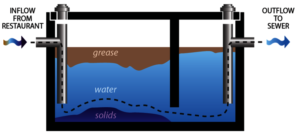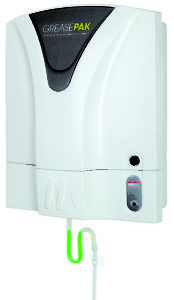Grease Traps: Yuk!!
What is a grease trap?
All catering kitchens from Restaurants to Hotels, Pubs to Takeaways, Schools to Nursing Homes create large amounts of grease. Think about it – oil fats from frying, fats cooking of meats, melted butter… where do these all go? Where do they end up? Answer: in our water systems. Without proper treatment huge lumps of fat can get stuck in pipes and create terrible problems in our waterways. So the kitchens use grease traps. You’ve probably seen one of these in most commercial kitchens, situated under the sinks:

It’s a traditional grease trap, connected to the waste sinks.
How do they work?
The grease trap basically filters the waste coming down the pipes from the sink. It separates the fats from the water, allowing the water to escape into the water system, preventing the fats from entering and blocking pipes further down. The fats are then left over in the tank. Here’s an easy diagram:

They have worked fine for about 100 years and the only complaint with this (actually very clever system) is that the fat left behind needs cleaning regularly, and nobody in the kitchen will ever volunteer to do it! Just look at it- and this one below is a relatively tidy one:

Also you’re lucky you can’t smell it because disturb the fat and you will be running to the toilet with you hand over your mouth! But unfortunately cleaning it is an essential job. If it’s not cleaned, all the grease ends up in pipes further down and just look at what can happen:

Your sinks will be blocked, the whole water system will be blocked. The grease will be overflowing in your lovely hygienic kitchen.
Yikes. Is there any other solution?
Thankfully yes! The Greasepak:

This small wall mounted unit takes care of it all by breaking down the fats using a bio-enzyme. Goodbye grease traps!














